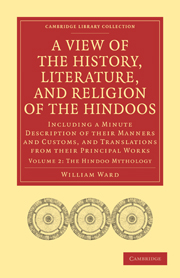 A View of the History, Literature, and Religion of the Hindoos
A View of the History, Literature, and Religion of the Hindoos Book contents
- Frontmatter
- Contents
- BOOK II OF THE TEMPLES, IMAGES, PRIESTS, AND TEMPLE WORSHIP OF THE HINDOOS
- BOOK III OF THE STATED PERIODS OF WORSHIP, AND VARIOUS DUTIES AND CEREMONIES
- BOOK V DOCTRINES OF THE HINDOO RELIGION
- BOOK VI
- BOOK VII HINDOO RELIGIOUS SECTS
- CHAP. I ACCOUNT OF THE REGULAR HINDOO SECTS
- CHAP. II ACCOUNT OF THE BOUDDHUS
- CHAP. III ACCOUNT OF THE JOINUS
- CHAP. IV ACCOUNT OF THE SHIKHS
- CHAP. V ACCOUNT OF THE FOLLOWERS OF CHOITUNYU
- CHAP. VI ANALYSIS OF ALL THE HINDOO SECTS
- CONCLUDING REMARKS
- APPENDIX: Scripture Illustrations from Hindoo Manners and Customs
CHAP. IV - ACCOUNT OF THE SHIKHS
Published online by Cambridge University Press: 29 August 2010
- Frontmatter
- Contents
- BOOK II OF THE TEMPLES, IMAGES, PRIESTS, AND TEMPLE WORSHIP OF THE HINDOOS
- BOOK III OF THE STATED PERIODS OF WORSHIP, AND VARIOUS DUTIES AND CEREMONIES
- BOOK V DOCTRINES OF THE HINDOO RELIGION
- BOOK VI
- BOOK VII HINDOO RELIGIOUS SECTS
- CHAP. I ACCOUNT OF THE REGULAR HINDOO SECTS
- CHAP. II ACCOUNT OF THE BOUDDHUS
- CHAP. III ACCOUNT OF THE JOINUS
- CHAP. IV ACCOUNT OF THE SHIKHS
- CHAP. V ACCOUNT OF THE FOLLOWERS OF CHOITUNYU
- CHAP. VI ANALYSIS OF ALL THE HINDOO SECTS
- CONCLUDING REMARKS
- APPENDIX: Scripture Illustrations from Hindoo Manners and Customs
Summary
The founder of this sect was Nanŭkŭ, a Hindoo of the kshŭtriyŭ cast, born in the year 1469, at Raibhoédēē-Tŭlŭwŭndēē, a village in the district of Majha, in the Pŭnjab.
Sir John Malcolm has related a number of particulars respecting the life and travels of Nanŭkŭ; the substance of which is, that he discovered an early attachment to a devout life, which his father found it impossible to counteract; and at length became famous as a prophet: according to Bhaee-Gooroo-Vŭlee, author of the Gnanŭ-Rŭtnavŭlee, a work in the shikh dialect, he travelled to all the sacred places of the Hindoos and Mŭsŭlmans, and even to Mecca. In these journies, as the author is informed by a learned shikh employed in the Serampore printing-office, he obtained many disciples; and at the time of his death, which happened when he was advanced in years, left not less than 100,000 persons in different countries who were attached to him as their religious guide.
Nanŭkŭ appears to have resembled Choitŭnyŭ, and many other Hindoos who have been celebrated for their attachment to forms of devotion, in preference to barren speculations and religious shews.
He maintained the doctrine of the divine unity, which, it is probable, he learned from the Mŭsŭlman mendicants, with whom he was very familiar: further, that God dwells in the devout, and that this divine inhabitation renders the ascetic an object of reverence and even of worship; and that hence it became a duty to seek the society of devout mendicants.
- Type
- Chapter
- Information
- A View of the History, Literature, and Religion of the HindoosIncluding a Minute Description of their Manners and Customs, and Translations from their Principal Works, pp. 270 - 289Publisher: Cambridge University PressPrint publication year: 2010First published in: 1817
